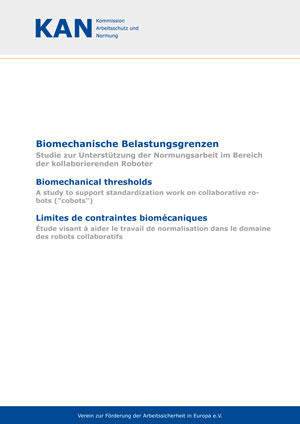KANBrief 3/14

Human beings and robots will collaborate more closely in the future. The spatial separation between the human being and the robot, which in the past was normal for safety reasons, is to be eliminated in order to make work easier and more ergonomic. However, even cutting-edge control technology cannot prevent unwanted collisions between humans and robots sharing the same working space. In such cases, it must be ensured that any such collisions have only a negligible impact upon health.
When are injuries so minor that their consequences can be regarded as negligible, and how can such strains be described? Can stress limits be defined for this purpose? If so, what resulting requirements can be formulated for robot design? Answers to the last of these questions in particular are being sought by the ISO/TC 184/SC 2 committee, which is responsible for the ISO 10218 series of standards, Robots and robotic devices – Safety requirements for industrial robots. The Woodworking and metalworking expert committee, which is responsible at the DGUV for the area of robotics, is active on this ISO committee and in conjunction with the IFA has commissioned research work and issued recommendations on the identification of hazards (Collaborative robots (COBOTS)).
To find a solution to this topical standardization problem, KAN tasked the Fraunhofer Institute for Factory Operation and Automation IFF in Magdeburg with examining what research results and limit values have been published since 1945 in German and English, and what research is still required (results of the study, pdf, in german). KAN has also issued recommendations on how minor injuries could be categorized and biomechanical stress limits structured.
A dearth of usable research results
245 databases and data libraries which appeared useful were surveyed for the purpose of the study. 1,036 of the research papers found there were evaluated for their relevance. Specific stress-strain relationships were identified in 100 of the individually inspected titles, and were entered into a database. Of these however, only 37 were found to be relevant for evaluation of the current state of progress of scientific research into the assessment of mechanical risks presented by collaborative robots. The number of available research projects in this area which could potentially be used to identify limit values is thus extremely small.
Categorization of the severity of injury
The severities of injury S1 and S2, on the basis of which the necessary protective measures can be identified during risk assessment, have already been established in machinery standards. The study proposes that two new categories – S0 and H – be introduced below S1 and S2 in future standardization projects.
S0 would describe minor injuries that heal completely and without consequences even without medical treatment. Such injuries are limited to contusion such as minor haematoma or swelling without abrasion or penetration of the epidermis. The injuries concerned are classified with reference to Part XIX of the International Statistical Classification of Diseases and Related Health Problems (ICD - International Statistical Classification of Diseases and Related Health Problems, Part XIX, „Injury, poisoning and certain other consequences of external causes“ ). Owing to its completeness and its use throughout the world, this classification is the most suitable for describing injury patterns in occupational safety and health.
H is to cover the "harmless" range below the threshold of pain incidence. This would enable forms of contact which do not cause pain to be classified as harmless for the purposes of risk assessment. The transition from H to S0 would be defined as the point at which pain occurs. Research into pain is required in order for these thresholds to be determined. In KAN's view however, the classification and distinction of categories for the severity of injury in standards should not be based upon the criterion of pain (effect), but upon the values defined by research of the biomechanical stress (cause) giving rise to this pain.
The standards committees, such as ISO TC 184, Automation systems and integration, and ISO TC 199, Safety of machinery, are responsible for taking up these proposals and adopting them in standardization activity.
Structuring of biomechanical stress limits
No physical variables were identified which could be used to formulate general and useful limits for biomechanical stresses for all conceivable strains and parts of the body. The crucial stress variables and their combinations are not known for a large number of strains. Despite this, the study developed a concept by means of which the anticipated strain can be read off in a system of co-ordinates for up to three variables or parameters for which values are available.
Corrado Mattiuzzo
mattiuzzo@kan.de